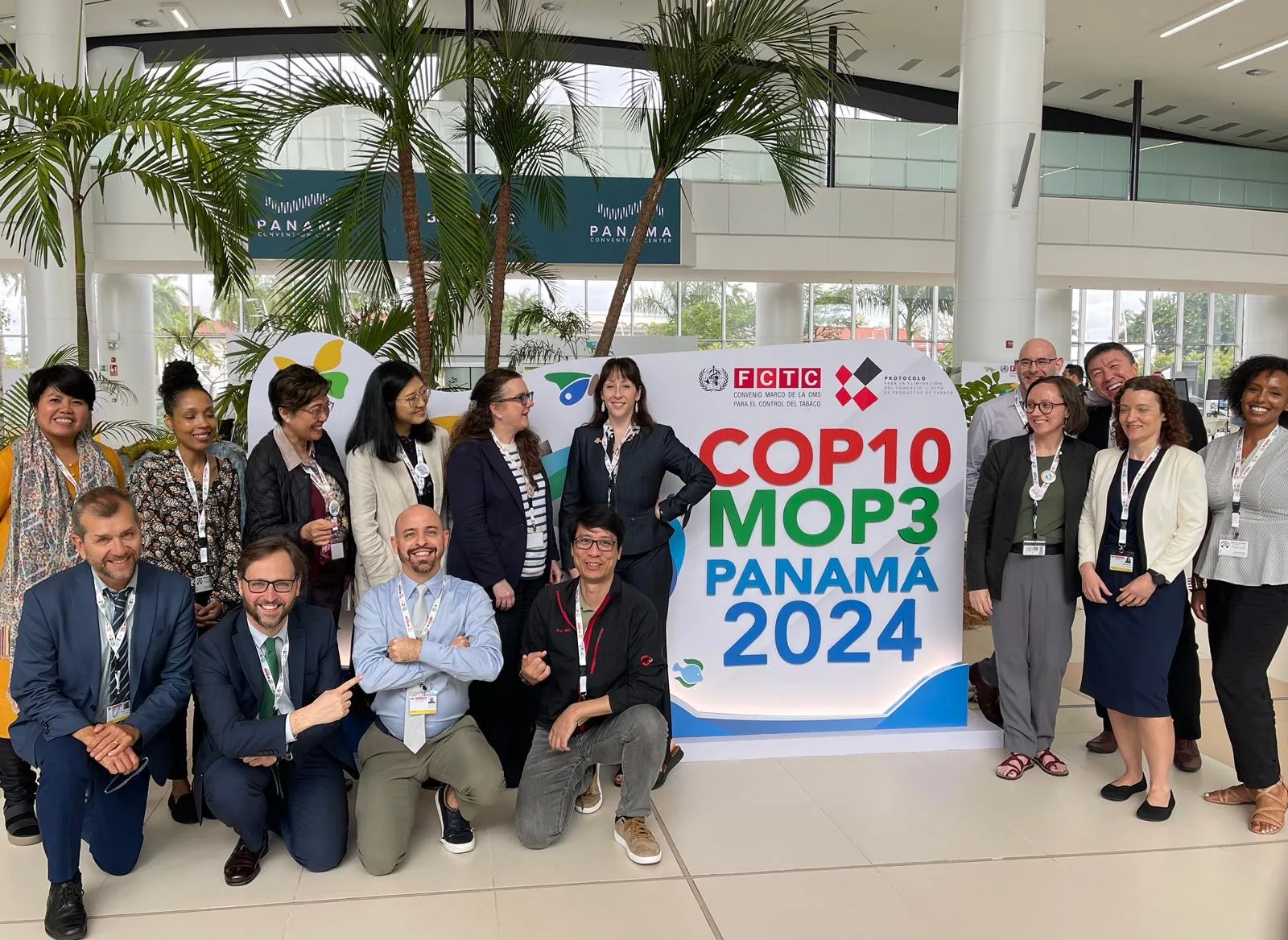- Resources
- News
-
-
Get Email Updates
Sign up for STOP's newsletter and never miss an update on our latest work and the tobacco industry's activity.
-
Get Funding
Ready to tackle industry interference? You could be eligible for a grant.
-
Share a Tip
Do you have information on tobacco industry misconduct in your country? Let us know.
-
Get Email Updates
Industry Marketing
November 21, 2022

Footballers might not be the only ones playing defense as the World Cup kicks off this week in Qatar. The Fédération Internationale de Football Association (FIFA) and Qatar’s Ministry of Health have put policies in place to keep tobacco sponsorship and tobacco products out of the games and stadiums in which they take place. But that doesn’t mean the tobacco industry won’t try to capitalize on the World Cup in other ways.
History shows tobacco companies are eager to associate their addictive and deadly products with sports and athletes, and have flouted anti-tobacco advertising policies in the past.
That’s why this is a critical moment for monitoring the industry’s activities. For one, monitoring and reporting on the tobacco industry’s activities works. Doing so has led to improvements in tobacco control policies around the world.
Monitoring the industry’s activities around the 2022 World Cup may also help the tobacco control community predict and prevent any advertising activities the industry may have planned for next year’s U-20 World Cup. The youth-oriented tournament, featuring players under age 20, is set to take place in Indonesia where the impact of industry involvement could be more severe due to the country’s weaker tobacco advertising regulations and the large youth audience.
Why the industry wants to be associated with sports
Think of the World Cup and excitement, energy and celebrity athletes will likely come to mind. Think of tobacco products, and you’ll probably envision the opposite. To distract from the many ways its products harm health, the industry leans into health-focused events and initiatives.
Phil Chamberlain of the University of Bath’s Tobacco Control Research Group noted in a recent Twitter chat hosted by the World Health Organization (WHO) that tobacco companies want, “…to be associated with the things that make sport interesting and exciting—it’s dynamic, it’s healthy, it’s cool. And those are things which tobacco is desperately keen to be associated with.”
And at an even more basic level, as Chamberlain put it, the industry “…needs to find new customers because too many of its customers die and it needs to replace those. And it will look for any means possible to attract new audiences.” Tobacco kills up to two-thirds of its users. If tobacco companies didn’t get more people hooked on their addictive products, they would go out of business. So they seek advertising opportunities, especially those that help them access younger audiences, such as sports tournaments.
Football’s history of tobacco sponsorship and involvement
Realizing football’s mass appeal, particularly among some of its target audiences, tobacco companies have found a multitude of ways to associate themselves with the sport. Both transnational and national tobacco companies have sponsored tournaments and teams.
A 1994 internal document from Philip Morris International (PMI) sheds light on why. PMI, maker of Marlboro cigarettes, laid out its motivations for targeting football fans. It stated that, in Asia, football was “…perceived as a very masculine, somewhat rugged sport; very popular among [young adult male smokers]…” and that there was “virtually no education required” to enjoy the sport. The company eventually sponsored the China National Football League, despite a law in the country banning tobacco advertising in sports stadiums. The sponsorship ended earlier than planned, in part due to enforcement of the advertising ban.
Tobacco companies have even purchased teams. In 2017, cigarette maker Nyasa Manufacturing Company bought Big Bullets FC in Malawi, and in 2019, Indonesian tobacco company Djarum bought an Italian football club.
The tobacco industry also has a history of sponsorship and involvement with the World Cup. In 1982, RJ Reynolds was an official sponsor of the World Cup and in 1986 advertised at the World Cup in Mexico, defying the country’s tobacco advertising bans.

To distract from the many ways its products harm health, the industry leans into health-focused events and initiatives.
What we might see around this year’s World Cup
Since then, FIFA has laid solid groundwork for keeping the industry out of the World Cup. As part of a memorandum of cooperation with WHO, in 2002 FIFA banned smoking at World Cup tournaments and has since extended this ban to include the use of e-cigarettes and heated tobacco products—with an exception for outdoor smoking areas. FIFA has also banned all tobacco advertising, promotion and sponsorship around the World Cup, and prohibits the sale of tobacco and related products at event sites. Further, Qatar has a smoke-free policy in place for public spaces.
But the industry has worked around such policies in the past, and may do so again. In some cases, tobacco companies have taken advantage of the global broadcast of the tournament, attaching their names to telecasts in places outside of the host country. For example, in 2002, the World Cup took place in South Korea and Japan. But in Malaysia, the World Cup was “proudly brought to you on Malaysian TV by Dunhill,” a cigarette brand owned by British American Tobacco (BAT). Similar advertising by BAT associated with the World Cup was also reported in Niger and Uruguay, and by PMI in Pakistan.
This affiliated advertising is still happening today. The “Zyn Arms” pub in London, a temporary pop-up establishment created by the Zyn brand nicotine pouch, which is sold by Swedish Match, now owned by PMI, is offering free nicotine pouches alongside very cheap drink deals during the World Cup. In addition, in the run up to this year’s World Cup, Djarum promoted its “Djarum Super Soccer Edition Packs,” featuring cigarette packs designed by Indonesian artists.
If these are the efforts we’re already seeing, what might these companies have planned for the U-20 World Cup next year? Especially concerning are potential sponsorship and advertising plans by Djarum, as the 2023 tournament will take place in its home country, which lacks fully comprehensive smoke-free policies and bans on tobacco advertising and sponsorship. The threat to public health will also be greater, as both the participants and the viewers will skew younger—the tobacco industry’s ideal target market.
Turning the World Cup into an anti-tobacco-industry messaging opportunity
The global reach of the World Cup presents an opportunity to reach millions of people with anti-tobacco messaging. In the run up to the tournament, Sport for Health, a coalition comprising members of WHO, the State of Qatar and FIFA, ran anti-tobacco messaging, and FIFA will be running anti-smoking public service announcements in the stadiums during the tournament. These not only reach those in attendance, but can trickle down to local levels, possibly reaching those watching around the world. Regardless of how active the industry may be in a given country, all people are receiving the same important message: Sports and tobacco do not mix.
Opportunity also lies in the training of workers and volunteers about anti-tobacco policies and how to enforce them. Each has a chance to stand against the industry and can become a vector for anti-tobacco messaging.
Help STOP monitor the 2022 World Cup
Tobacco has no place in sports. If you see tobacco and nicotine companies using the World Cup in their advertising or messaging—in Qatar or anywhere—let us know. Reach out on the STOP website or via Tobacco Tactics.




